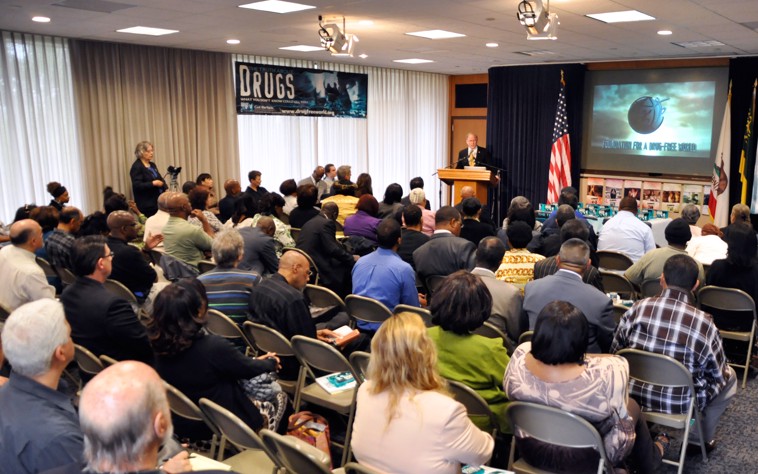A City Under the Influence
Frederick Hernandez was a statistic, a casualty, a cautionary tale—a drug addict. What he could not possibly know as he was about to hit bottom was that with a little education would soon come knowledge, and with knowledge would come sobriety.
But back in 2012, all Hernandez knew was that he was in deep trouble. Along with his wife, his was the worst kind of nightmare, strung out on a virtual pharmacy of illicit narcotics while their 3-year-old and 7-month-old played nearby in a poor neighborhood of South Central Los Angeles. His drugs of choice were crack, heroin, PCP, marijuana, meth, alcohol…well, it seemed they were all his drugs of choice.
“This was my lifestyle, if you can even call it that,” Hernandez recalled. “I had nothing to do but escape from reality. When you’re friends with the wrong people, this is what happens. The kids would stay in the other room watching TV, and we just stayed high all the time.”
Hernandez may be an extreme example, but he is by no means an isolated one. The horror stories about drug abuse in the city of Los Angeles and its environs abound—and for good reason. L.A. is a hotbed of drugs both legal and illicit. Upscale adolescents, suburban housewives and middle-aged thrillseekers do them. Gangs wage turf wars over them.
Far from existing as the exclusive domain of street junkies and vagrants, the L.A. drug scene crosses every economic strata and demographic of perhaps the most culturally diverse area in the world.
There are, of course, alcoholics, their drug readily available, legal, pervasive, cheap and socially acceptable (except perhaps in falling-over-in-public amounts). Alcohol can be found everywhere without prescription, as can alcoholics, from upper-middle-class abusers of single-malt scotch in the Hollywood Hills to the lowest winos on downtown’s Skid Row.
Crystal methamphetamine is a poison that infects predominantly gay and bisexual neighborhoods of the city (largely West Hollywood and Silver Lake) due to its property of helping its users remain awake and sexually active for days and nights at a stretch. Along with that comes violent behavior, convulsions, intense mood swings, tooth decay and heart attacks.
There is also heroin, which has returned with a vengeance in recent years. Attention became fixed on it last year following the tragic overdose death of actor Philip Seymour Hoffman in New York. But it is all over Southern California as well. Contrary to the image of emaciated junkies shooting up in dark alleys, heroin abusers today live in the finest white-collar suburban neighborhoods—because they can afford it, from Beverly Hills and Bel Air in the west to Encino and Agoura to the north.
A massive menace in the 1950s and 60’s, heroin started making a comeback some 10 years ago. Glen Walsh, a sergeant in the Narcotics Bureau of the Los Angeles County Sheriff’s Department, observed that its use and availability greatly increased after the price of crystal meth skyrocketed when heroin production shifted to Mexico.
“At about that same time, Mexico started cultivating poppies and producing heroin,” Sgt. Walsh explains. “When I first started working dope, a kilo of heroin (2.2 pounds) ran over $60,000 on the street. Now it’s about $28,000 a kilo.” Sgt. Walsh adds that heroin is significantly less expensive now than, say, such drugs as the painkillers OxyContin and Percocet. And no prescription is necessary. You just need to know where to look.
In Los Angeles, as in other cities across the country, traditional methods such as hard-line law enforcement have resulted in little change in drug abuse.
But with the help of a landmark education program, the tide is starting to turn.
Increasingly, that place has been the San Fernando Valley area of Los Angeles, a region collectively home to some 1.8 million people, where abuse of heroin has skyrocketed since shortly after the turn of the millennium. One of the reasons: the insidious drug is now readily available in a “smokeable” form as a blend with marijuana that need not be injected to have the desired narcotic effect. A Heroin Kills symposium in January 2014 sponsored by the nonprofit Because I Love You sounded the alarm to the teen heroin scourge in the area.
While crack and cocaine may not be the problem they were a decade ago in Los Angeles, when crack houses littered the South Central ghetto and affluent wage earners snorted the powdered form, it is still out there, funding a criminal enterprise and taking down lives.
Pills, too, are abused in all areas. The suburban housewife community in Sherman Oaks and Santa Monica likes its painkillers and sedatives, once dubbed by the Rolling Stones as “Mother’s Little Helpers.” Unethical doctors are only too happy to scribble out prescriptions for Vicodin and OxyContin…for a price.
And there is marijuana.
Weed. Pot. Grass. Cannabis. Reefer. Homegrown. Mary Jane. By any name, it is still most popular in its smoked form in joints, pipes and bongs but is increasingly used in its even more potent edible form in foods including candy bars. This has grown more common as the number of medical marijuana dispensaries in L.A. has skyrocketed well into the hundreds.
In some circles, marijuana is hardly considered a drug anymore. “Weed is harmless” is the claim. It just became legal for recreational use in the state of Colorado. What is missing from this picture? Here’s a glimpse:
Fact: In a chart of Los Angeles County drug abuse patterns for the six months between January and June of 2013, there were more hospitalizations and admissions for treatment of marijuana abuse than any other drug—including alcohol. Some 27 percent of all admissions were for marijuana, while just 22 percent were for alcohol, 20 percent for heroin, 19 percent for meth, 7 percent for cocaine and crack, and 5 percent for other drugs.
Fact: More than half (59 percent) of the primary marijuana admissions for treatment of addiction in Los Angeles County were for those younger than 18.
Fact: Indisputable evidence shows that marijuana is known to greatly decrease the attention span and acuity of its users. Evidence also points to the probability that a significant percentage of auto accidents stem at least in part from its ingestion.
Fact: A majority of the perpetrators of mass shootings over the past two decades were either chronic marijuana abusers or high on it at the time of the event itself. That includes pot cultivator Jared Lee Loughner, the convicted murderer who also shot and nearly killed Congresswoman Gabrielle Giffords in Arizona in 2011.
Fact: A Columbia University Mailman School of Public Health report, released in February 2014, revealed that fatal crashes involving marijuana use tripled during the previous decade. Said one of the co-authors, “Currently, one of nine drivers involved in fatal crashes would test positive for marijuana.”
Fact: A 2010 Harvard Mental Health Letter study found that as a treatment for psychiatric disorders, the risks of marijuana use exceed the benefits in that regular use “can lead to addiction and other mental health problems, especially in people who are genetically vulnerable.”
The larger war on drugs in the United States has received more than $1 trillion in federal funding since being launched. The government tally on the incarceration and care of some 500,000 inmates imprisoned on drug-related offenses in the United States is more than $12 billion annually. More is spent on caring for drug offenders, in fact, than on public education.
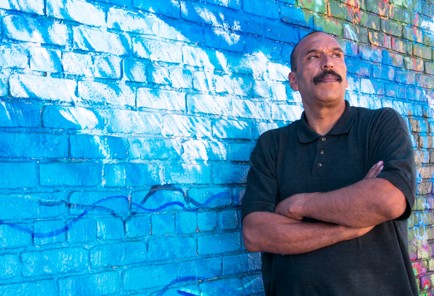
In Los Angeles, overdose remains one of the leading causes of both premature and general death in the metropolitan area, in part due to the dramatic increase in fatalities from prescription drugs (which nationally eclipse those of cocaine and heroin combined). So alarming has the problem become that a Los Angeles Overdose Prevention Task Force has been launched.
What makes L.A. such a hotbed of drug abuse is perhaps the city’s short distance from Mexico, a manufacturing and smuggling hub controlled by various drug cartels. “Because of the proximity to the southwest border, most of the drugs in L.A. come from Mexico,” confirms Vijay Rathi, a special agent with the Drug Enforcement Administration.
The primary drugs that feed into L.A. from south of the border are heroin (the “black tar” variety in particular), cocaine, methamphetamine and marijuana, Rathi says. Marijuana also originates in Afghanistan, where it gets run through Europe before being smuggled into the United States.
“We see drugs get into L.A. in cars, big trucks, via body couriers strapping it on, or by boat—passed off as legitimate goods,” Rathi reports. “And in a lot of cases, once the drugs arrive here, they don’t leave but are bought and consumed locally.”
In terms of consumption, the perception of marijuana as a “gateway” drug that can open the door to abuse of more harmful narcotics is increasingly supplanted by the view of marijuana as the gate itself.
One man who believes this to be true is Sgt. Walsh. He widely promotes that far from being a harmless diversion at worst or, at best, the wonder medicine of our time, marijuana can and does create long-term damage to its users. “The younger you start, the more psychotic episodes and difficulties you’re going to have during the course of your life,” Walsh maintains, “because of what marijuana does to the way your brain maps itself.”
What has led to the local marijuana addiction and treatment epidemic, Walsh believes, is the greatly increased potency of today’s drug. He points out that in the 1960s and ‘70s, the concentration of THC (the herb’s psychoactive component) in pot stood at about 3 percent, leading to more of a sedative effect.
“Now you can easily get marijuana with THC that averages 12 to 15 percent and some strains even higher,” Walsh says. “It used to be kind of a depressant that mellowed you out. But at the higher THC doses, it turns into a heavy-duty stimulant. And beyond 12 percent THC, we’re talking about a very potent and dangerous hallucinogen that does severe damage to the brain’s neurotransmitters.” Walsh indicated they are already starting to see even stronger varieties. And according to the University of Mississippi, the THC level of marijuana has recently experienced an alarming rise, leaping as high as 36 percent.
Walsh added that the impact on brain chemistry and the way chemical messages are routed increases dramatically for children and teens experimenting with marijuana. And even in adults, it leads to intense anxiety and panic attacks. Moreover, the increased potency is thought by addiction specialists to accelerate development of dependence. That would help explain the soaring treatment numbers.
In Colorado, where recreational marijuana was legalized in January 2014, state hospital officials report a growing number of children and adults sickened by edible marijuana—while neighboring states are seeing an increased number of stoned drivers.
This is also to say nothing of the cost from drug abuse in general—and the marijuana boom in particular—in lost job productivity, mental dullness and social fallout. “A community or society on drugs is one unable to function at anything approaching optimum efficiency, physically and psychologically,” according to the Los Angeles-based Foundation for a Drug-Free World.
SAN FERNANDO VALLEY
In early 2014, the LAPD reported an increase in heroin use in the Valley over the past 10 years, particularly Mexican black tar heroin which can be smoked.GLENDALE
Cocaine remains the drug most easily available, with marijuana a close second.HOLLYWOOD
The Church of Scientology of Los Angeles is active with the international program Truth About Drugs that utilizes the drug education materials of the Foundation for a Drug-Free World.MALIBU BEACH
In recent years, big marijuana-growing busts in the Malibu area have occurred about once per year. The street value of the confiscated plants has run as high as $100 million.SANTA MONICA
Police report that Ecstasy is available at high levels in the area.WEST HOLLYWOOD
Arrests for possession or sale of methamphetamine, cocaine, heroin and GHB (a powerful central nervous system depressant) increased in the last half of 2013. Meth accounted for the largest number of arrests.INGLEWOOD
The Community Center of the Church of Scientology Inglewood offers drug education services utilizing materials from Foundation for a Drug-Free World.EAST LOS ANGELES
Through collaboration between the Los Angeles County Sheriff’s Department, community-based organizations, volunteers, schools and families, Vital Intervention and Directional Alternatives (VIDA) teaches youth the value of effective decision-making and taking responsibility for their futures.DOWNTOWN L.A.
In 1983, the LAPD launched the Drug Abuse Resistance Education (D.A.R.E.) Program, a strategy designed to help prevent drug abuse by youth. Over the years, D.A.R.E. became one of the principal means for the LAPD to create positive interactions between officers and the community.COMPTON
The area is the primary source for the majority of PCP (angel dust, Ashy Larry, illy, or wet) found in the United States. Though not as widely popular as most rave drugs, LSD remains readily available throughout the Los Angeles area.LONG BEACH
Police reported a rise in heroin use in the area in 2014, mainly among young people. Nationwide, 669,000 people reported using heroin in 2012, up from 373,000 in 2007.ORANGE COUNTY
Hit hard by overdose deaths and emergency room visits, Orange County and Santa Clara County in May 2014 sued five of the world's largest drug manufacturers, accusing them of causing the nation's prescription drug epidemic by waging a "campaign of deception" aimed at boosting sales of potent painkillers such as OxyContin.Even media people are writing about their sometimes horrific experiences with today’s significantly stronger marijuana. One graphic example came from an unlikely source: New York Times columnist Maureen Dowd, who wrote in June 2014 about the terrifying aftermath of eating a marijuana-laced candy bar earlier this year while researching the pot culture in Colorado.
“I felt a scary shudder go through my body and brain,” she wrote. “I barely made it from the desk to the bed, where I lay curled up in a hallucinatory state for the next eight hours. I was thirsty but couldn’t move to get water. Or even turn off the lights. I strained to remember where I was or even what I was wearing. As my paranoia deepened, I was convinced that I had died and no one was telling me.”
Yet despite such accounts, the quantum shift of marijuana acceptance in popular culture continues. Dowd’s very own New York Times in late July called on the federal government—in a resounding editorial—to repeal the “Prohibition” ban on the production, sale and use of marijuana in all its forms. A multipart series that followed opined that the federal weed ban was “rooted in myth and xenophobia” and largely minimized the drug’s negative impact on health (including on the development of the adolescent brain).
Meanwhile, in film and on television, we are asked to laugh at the silly stoner and his or her slow-witted, weed-compromised thinking. It used to be that way with alcoholics, guffawing at the tipsy drinkers like those portrayed by Foster Brooks and the character of Otis, the lovable town drunk on The Andy Griffith Show. But the preponderance of drunken driving tragedies made it politically untenable, and so those under the influence of weed have replaced them as the butt of jokes and satire.
There was nothing funny about it to Ryan (a pseudonym), however. On the condition of anonymity, he spoke with Freedom following a Marijuana Anonymous meeting.
“I thought I had (marijuana) under control, but it was controlling me,” he said. “It sneaks up on you. I didn’t even realize I’d stopped doing everything, except work, and even that was less and less. I stopped going to parties. The only friends I saw were the ones I smoked with. I lost my will to go out and live life, and that was all due to my addiction.”
So Ryan found marijuana to be addictive?
“Look around you,” he said, pointing to a room filled with admitted addicts. “It was the same for all of us. Marijuana started out as something fun, then became a crutch, then finally took over and made my life unmanageable.” Ryan said he had been clean for 18 months.
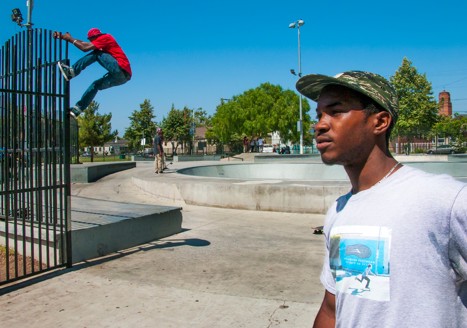
Eric, a 20-year-old hanging out at a skateboard park in Compton in the center of illegal drug activity, said he doesn’t use drugs. “I just smoke a little bud, that’s it,” he said. But didn’t he consider marijuana to be a drug? “Not really,” he admitted. “It’s just something we all do to kind of wind down after skateboarding.”
In this context, “wind down” means lose yourself in a narcotic-fueled haze.
A growing consortium of Angelenos assert that what Eric needs more than getting high is to get educated, as tens of thousands of others have. Evidence points to the reality that once they understand the potential consequences of even casual drug use, young people are far less likely to start taking drugs and many never start.
It is for this reason that the Churches of Scientology and Scientologists support The Truth About Drugs program, an education and prevention initiative that fosters drug and crime prevention and whose ultimate goal is to keep kids and adults from ever picking up and using dangerous drugs.
While The Truth About Drugs is not a rehab program, it can help to make inroads in the drug epidemic and promote sobriety through information. Knowledge, in this case, is power. That certainly turned out to be the case for Frederick Hernandez, the man described at the beginning of this story.
After two officers from the L.A. County Department of Children and Family Services took away his children, Hernandez rose up off the floor of his drug den, shook the cobwebs from his head, put down the syringe and sought help. He found that help while facing the facts of his addiction.
“I didn’t know who I was until I read the Truth About Drugs booklet,” Hernandez said. “The message changed my life—and after about nine months, I can say that I was rehabilitated.”
It took courage and determination for Hernandez to regain custody of his children, but after counseling and community service and proven abstention from drugs, he was reunited with them in February 2014. His wife remains on the street, a lost soul adrift in the narcotics sea, but Frederick has now been clean for more than two years, living with his kids in the Dream Center, a Los Angeles residential rehab facility.
Of course, not all addict stories find such happy endings. But the Truth About Drugs materials and initiatives help to make them possible. The program’s plain-talk, no-scare-tactics booklets, lesson plans, public service announcements and an acclaimed documentary have been incorporated by more than 1,200 government agencies, law enforcement groups, youth foundations, prisons and religious organizations all over the world, along with 10,000 schools.
In Los Angeles, that includes some 44 deputy sheriffs in 13 stations and 100 clergy now certified as Drug-Free World Prevention Specialists working with at-risk youth.
Through a worldwide network of volunteers, more than 50 million drug prevention booklets have been distributed and tens of thousands of drug awareness events held in 180 countries. But going beyond the numbers, it’s all simply a matter of education, which the Foundation for a Drug-Free World has been dedicated to since the secular, nonprofit corporation’s founding in 2006.
One of those who has embraced the Truth About Drugs program is Sergeant Mark Cripe, county-wide director of the L.A. County Sheriff’s VIDA (Vital Intervention and Directional Alternatives) program. He has been using the Truth About Drugs curriculum with at-risk young people since 2008.
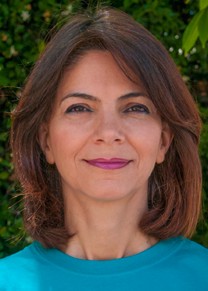
Why does he use it? “Because it’s the best,” he says. “The quality and the message is such that it creates moments when epiphanies occur.”
Echoing that sentiment is Jesse Mendoza, a youth community organizer who is also affiliated with VIDA. “I have used the Truth About Drugs as a prevention program with at-risk kids. The students admit that the message gets to them and helps them make a responsible decision.” He particularly values the program’s public service spots and feature-length documentary, “The Truth About Drugs: Real People, Real Stories.”
The Truth About Drugs program has also worked in tandem with the L.A. County Sheriff’s Success Through Awareness and Resistance (STAR) Unit that provides drug, gang and violence prevention education to students throughout the county.
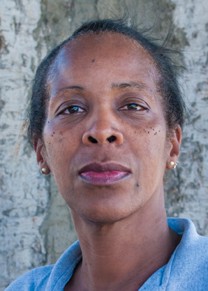
Shanna Sterling is a Scientologist who volunteers as a campus aide at Fairfax High School in L.A., bringing her experience and wisdom to kids who have used drugs or are at risk of using them. As part of that work, she brought 3,000 Truth About Drugs booklets to hand out to students and found that the information they contained not only resonated but was embraced.
“Most of the students who read them said, ‘I didn’t know drugs could do that to you,’” she said. Most of the kids were unaware of the potential health hazards of regular or even occasional drug use, Sterling noted. “It helped them understand how these substances damage their bodies, what addiction means—and gives them a reason and the conviction to say ‘No.’”
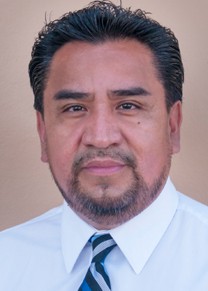
That is also the message of the Rev. Roberto Recillas, founder and executive director of the I Believe in My Future initiative in Downey, California, that is dedicated to educating and inspiring children, parents and families about the dangers of drugs. For the past three years, he has conducted Truth About Drugs Seminars attended by more than 3,000 parents.
“I have seen how drugs can damage families,” said Rev. Recillas. “The material I use as a seminar leader does a great job educating kids about what drugs can do to the body and mind. And once they learn, they share the material with their peers because they all know somebody who is doing or selling drugs.”
Koko Tabibzadeh got involved in the fight against drug abuse two years ago after reading about a 15-year-old boy who died after ingesting a few random pills out of a bowl passed around at a party. Instrumental in subsequently convincing a pair of Los Angeles-area high schools to show the Truth About Drugs video to the freshman class, she said, “Kids and parents have to know what the effects of drugs truly are—because I think if they really do know, they won’t do it”
Felipe Rodriguez, a supervisor with Behavioral Health Services, has been using the Truth About Drugs initiative for more than two years in after-school programs with adolescents and in parenting classes. He told Freedom, “Most kids aren’t aware of the effects of certain drugs on the body, mind and spirit. They don’t understand how damaging they can be in the long run, and especially that marijuana is more dangerous these days than it used to be.”
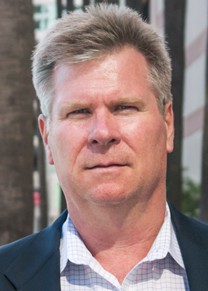
Rodriguez finds the Truth About Drugs to be “an effective prevention program that helps kids who are at risk make a responsible decision about taking drugs.”
Mark and Carol Loweree, Scientologists active in the Truth About Drugs program, emphasize that education and prevention will reduce the need for rehab down the road. Their involvement started when they were approached by a police captain looking for ways to fight drug abuse in their community. “It isn’t just a law enforcement problem—it’s a prevention problem too,” says Loweree. “It requires widespread, effective drug education that really gets the message across. So, when the captain asked for our help, we didn’t hesitate.”
The Lowerees have made their Truth About Drugs presentations to “many thousands” of children and teenagers in the San Fernando Valley area where they live.
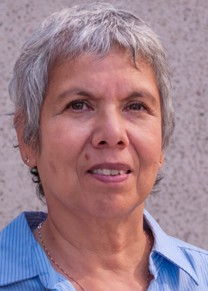
Soon after they began doing their seminars, Mark and Carol were approached by clergy members interested in the program for their congregations. Over the past 2½ years, the Lowerees, local pastors and other volunteers have conducted or helped to spark more than 100 seminars that have inspired more than 13,000 kids and teens to take a drug-free pledge.
But the Lowerees understand that abundant challenges remain in separating the truth from the lies about drugs, particularly marijuana, in light of its enhanced THC potency and the general myopia about its potential dangers.
“In my insurance business, I’ve noticed over the last few years that life insurance companies treat many marijuana smokers the same as they do cigarette smokers—as if they’re similar,” Loweree says. “For drugs like cocaine or Ecstasy, a person would be denied insurance instantly, but not for marijuana. This tells me that the education surrounding marijuana’s harmful effects is more important than ever.”
If even the insurance industry needs convincing that marijuana should be viewed as an actual narcotic, it should be no surprise that a January 2014 National Institutes of Health survey found that, in 2013, only 39.5 percent of 12th graders viewed regular marijuana use as harmful—a staggering drop from 72.5 percent just 20 years earlier. Experts point to recent marijuana legalization campaigns for the perception change.
When students read the Truth About Drugs materials, they ask me ‘Is this really what can happen to me if I use drugs?’ It makes them think. The younger generation wants to be healthier than the previous one.
— Commander Dennis Kato, Los Angeles Police Dept.
There are nonetheless zero tolerance policies in many institutions when it comes to marijuana. This is the case at Duke Ellington Continuation High School in South Los Angeles, where Principal Cecil McLinn proudly presides over a smoke-free campus for his 156 at-risk students.
“It’s easy to get drugs and weapons in this community,” McLinn acknowledges, “but I believe there are no dealers or users on this campus. The kids respect the culture of this campus that we have established.”
But as the Truth About Drugs program continues to become more broadly utilized, remarkable results can and do happen in terms of education. Consider the case of Roger Davis, who wound up doing three years in prison for selling drugs on the streets of Harlem. Davis did his time and moved to Los Angeles, where he resolved to build a real future for himself and become a contributing member of society.
He trained with 200 community leaders in a drug education program organized by the Clergy Council of the L.A. County Sheriff’s Department. It was there he found the Truth About Drugs program.
“Knowing the truth can really set you free,” Davis says. “I regained self-respect, and now I can walk with my head held high. Now I want others to join me and make a significant change in their lives like I did in mine.”
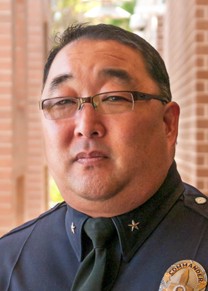
What Davis did was bring the Truth About Drugs program to Victorville Federal Prison in Southern California’s San Bernardino County, where he trained 17 inmates as mentors to offer the program to other prisoners. They, in turn, have gone on to train hundreds of other inmates.
“Thanks to this education program,” Davis said, “one of the inmates reduced his prison time by five years for good conduct.”
Commander Dennis Kato of the Los Angeles Police Department is a champion of drug education and the Truth About Drugs program. “The message goes to everybody. It’s simple, it’s not complicated, you don’t need a science degree to understand it—kids as young as 10 can understand it and so can adults,” he says.
“The police force is not going to change the ills of society by arresting every drug user we see. We are evolving into establishing partnerships with community organizations such as the Foundation for a Drug-Free World. The more we partner, the more we reach a broader audience.”
